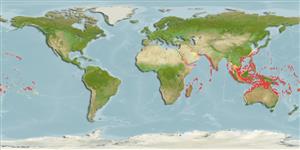>
Acanthuriformes (Surgeonfishes) >
Acanthuridae (Surgeonfishes, tangs, unicornfishes) > Acanthurinae
Etymology: Zebrasoma: Derived from Zebra = African horse + Greek, soma = body; referring to the stripes (Ref. 45335).
More on author: Cuvier.
Environment: milieu / climate zone / depth range / distribution range
Ecologie
marien rifbewoner; diepte 0 - 60 m (Ref. 1602), usually 1 - 60 m (Ref. 27115). Tropical; 25°C - 28°C (Ref. 27115); 31°N - 34°S, 32°E - 124°W
Indo-Pacific: East Africa, including the Mascarene Islands (Ref. 37792) to the Tuamoto Islands, north to southern Japan, south to Lord Howe and Rapa islands.
Grootte / Gewicht / Leeftijd
Maturity: Lm ? range ? - ? cm
Max length : 40.0 cm SL mannelijk / geslacht onbekend; (Ref. 48637)
Dorsale stekels (totaal): 4 - 5; Dorsale zachte stralen (totaal): 23-25; Anale stekels 3; Anale zachte stralen: 19 - 21. Dark brown (body in life with fine pale blue-green longitudinal lines following scale rows, becoming dots anteriorly on body and on head) (Ref 9808). Small juveniles have yellowish bars and more prominent yellow specks than adults.
Occurs in coral-rich areas of lagoon and seaward reefs. Graze on algae, usually in groups of 20 individuals (Ref. 5503, 48637). Adults usually in small groups and sometimes schooling. Juveniles solitary and usually among corals (Ref. 48637). Its numerous, small pharyngeal teeth may have evolved in response to a shift in diet from macroalgae to filamentous algae (Ref. 33204). Form resident spawning aggregations (Ref. 27825). Monogamous (Ref. 52884). Group and pair spawning have been observed. The flesh is never poisonous (Ref. 4795). Minimum depth reported taken from Ref. 128797.
Levenscyclus en paargedrag
Maturiteit | Voortplanting | Paaien | Eieren | Fecunditeit | Larven
Form resident spawning aggregations (Ref. 27825). Monogamous mating is observed as both facultative and social (Ref. 52884).
Myers, R.F., 1991. Micronesian reef fishes. Second Ed. Coral Graphics, Barrigada, Guam. 298 p. (Ref. 1602)
Status op de Rode Lijst van het IUCN (Ref. 130435)
Gevaar voor de mens
Harmless
Gebruik door de mens
Aquarium: Commercieel
Meer informatie
ReferentiesAquacultuurAquacultuurprofielKweeklijnenGeneticaElectrophoresesErfelijkheidZiektesVerwerkingNutrientsMassaconversie
Tools
Speciale rapporten
Download XML
Internetbronnen
Estimates based on models
Preferred temperature (Ref.
123201): 24.6 - 28.9, mean 27.6 °C (based on 1646 cells).
Fylogenetische diversiteitsindex (Ref.
82804): PD
50 = 0.5078 [Uniqueness, from 0.5 = low to 2.0 = high].
Bayesian length-weight: a=0.02512 (0.02073 - 0.03043), b=2.98 (2.93 - 3.03), in cm total length, based on LWR estimates for this species (Ref.
93245).
Trofisch niveau (Ref.
69278): 2.0 ±0.00 se; based on food items.
Weerstandsvermogen (Ref.
120179): Gemiddeld, minimale populatieverdubbelingstijd 1,4-4,4 jaar (K=0.425; Tmax=33).
Fishing Vulnerability (Ref.
59153): Moderate vulnerability (39 of 100).
Nutrients (Ref.
124155): Calcium = 25 [11, 80] mg/100g; Iron = 0.636 [0.219, 1.541] mg/100g; Protein = 17.8 [16.4, 19.2] %; Omega3 = 0.126 [0.058, 0.270] g/100g; Selenium = 14.1 [4.5, 75.6] μg/100g; VitaminA = 57.3 [10.9, 272.4] μg/100g; Zinc = 2.04 [0.90, 3.68] mg/100g (wet weight);
